If you want to skip directly to the other parts, then just hit
Part II - Kunming, Dali, or
Part III - Nanning, Hainan, Canton
Introduction
This is an abridged description of a roundtrip through Southern China (see map below) commencing October 1988. The intention is to give a firsthand personal experience of how we, Manfred and I, did get to and through the country. Despite the fact that we did not book anything in advance at all (except for the flight to Hongkong) and that we covered more than 5,000km within the country during the 30 days, it was no problem getting any means of transport (even domestic flights) or accommodation on the same day. I only did some kind of pre-planning in so far that we wanted to be back in Hongkong at least a day before my scheduled return flight to Germany and Manfred's flight to the Philippines.
At the time of writing all this, more than 20 years have passed. What I had seen and experienced, may not be the way today anymore. Cultures and customs change rapidly in our global world, especially in China, not necessarily to the better.
Definitely prices have changed thus I will only list some of them, but in US Dollars (though with a better exchange rate at that time as today, i.e. almost one USD to two DM or one Euro) to give you an idea of how we traveled on the cheap at that time.
Sometimes, I slip into a writing habit:
It's like a tic,
I can't help it.
If you won't read it,
then just leave it
and take the liberty
to skip my silly poetry.
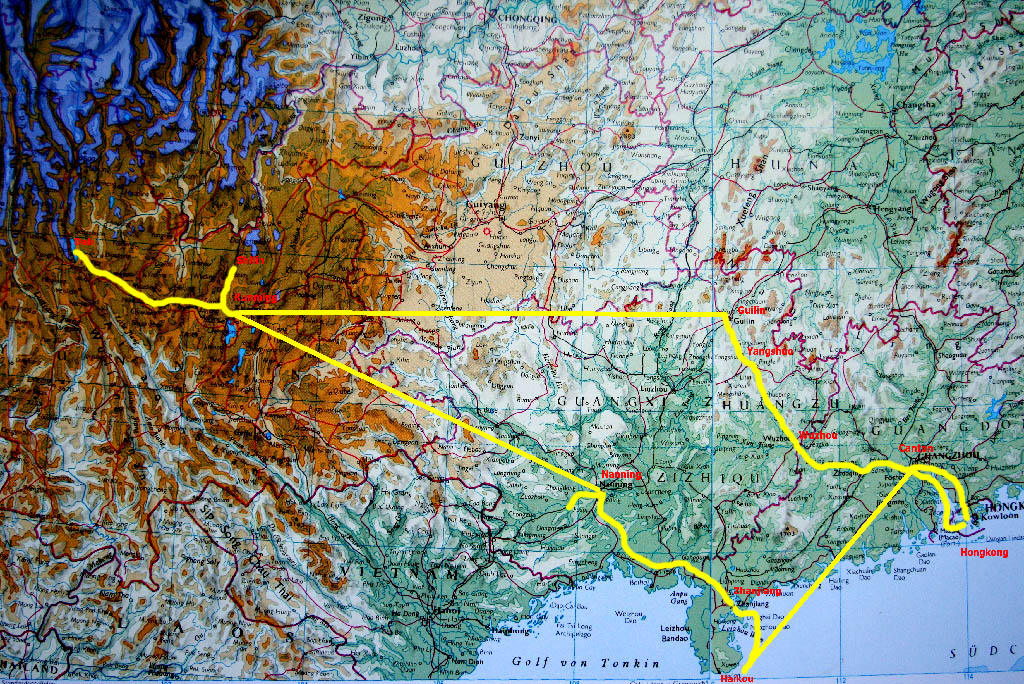
Getting from Germany to Hongkong
The round trip ticket from Frankfurt to Hongkong with Alitalia (with stopover in Rome) did cost 1,700 DM (almost 850 USD).
In order to get from Cologne to Frankfurt I had to take the train. Arrival time in Hongkong was late afternoon. Manfred was already waiting in the airport for me, because he came from Taiwan the previous day.
Hongkong
Manfred had already made reservation for the next couple of days in some kind of a student guesthouse, the
where we paid around 6 USD for a dorm bed.
The YMCA would have been much better, but it was fully booked. At least we went there for its famous buffet lunch for around 4 USD.
Next morning we applied for a visa for China. That was easy and much easier than trying to get the visa in Germany. China has opened its borders for western tourists just recently, and only via package tours at that time. The guesthouse offered to obtain the visa for us within three days for a small fee (express visa in one day would have cost a little more).
Remark: The photos on the right side may not be correctly adjusted if you use Mozilla Firefox or Chrome. I propose to use the Explorer of Microsoft instead.
Click the small picture to get it enlarged
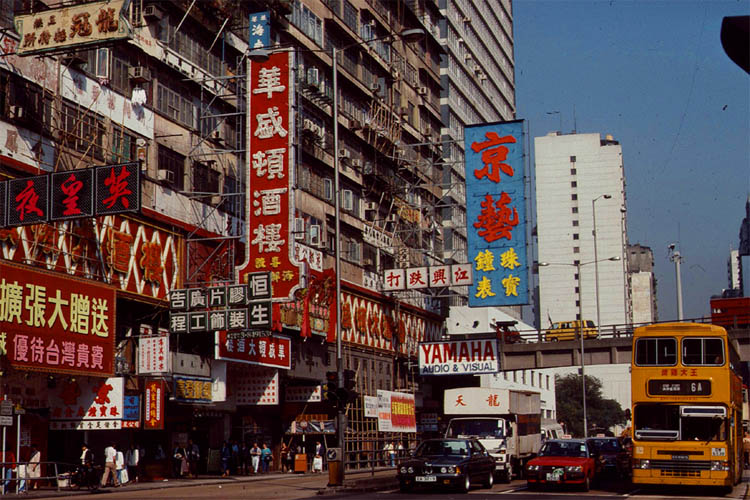
| Kowloon by day
|
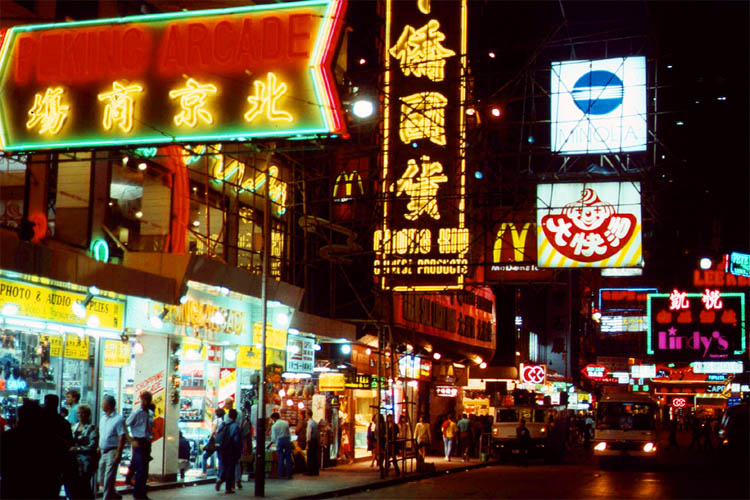
| Kowloon by night
|
So we had a couple of days to look around Kowloon and to see Christine on Hongkong Island. She was an English friend living in Cologne who visited, together with her French girl friend, Françoise, another English girl friend, Jean, married to an English policeman, who had a two years assignment to the Hongkong Police Narcotics Department to help to solve the drug problems there.
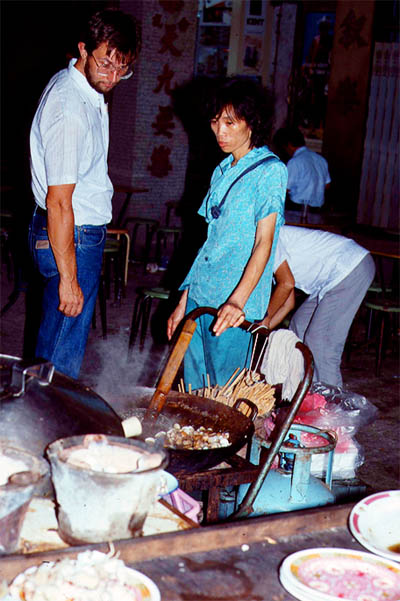
| Shall we eat here
|

| or shall we eat there
|
At first we were strolling in the streets of Kowloon. Except for the waterfront district, directly opposite Hongkong Island, it was still a little bit my old Hongkong from my first trip in 1969: eateries and markets, old buildings with Chinese stores, the night market with food stalls and all kinds of fortune-tellers.
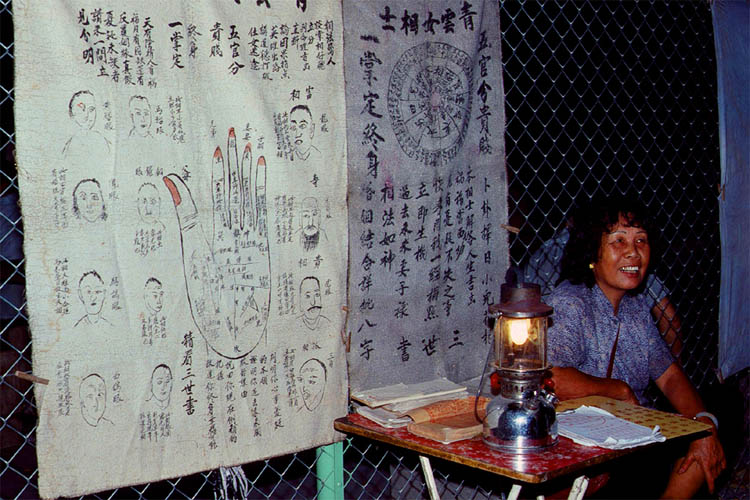
| Having the palm read for that
|

| or believe in Buddha or bet
|
Next day we met Christine and Françoise at some place on Hongkong Island, easily to be reached with the modern Underground (in 1969 I had to take the good old ferry).
We were not much up to walking, especially not up the hill, so we took the cable car.

| First walking in a Kowloon street
|

| then got onto the Hongkong peak
|
Hongkong city became one of the most modern cities in Asia, beside Singapore. Many of the old quarters had been torn down to make room for modern high-rise buildings. But there were also communities with small houses. We visited the house of Christine's friend in a very nice neighborhood. Yes, I would have liked to live in Hongkong, too, with also much to do.
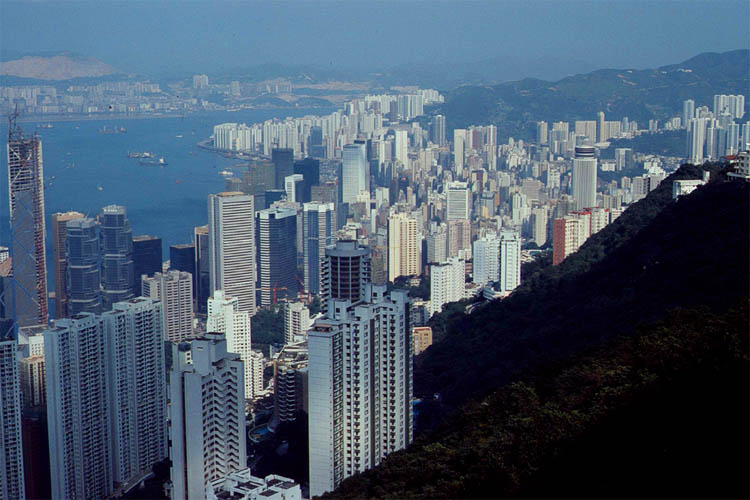
| That's Hongkong, what a nice view
|
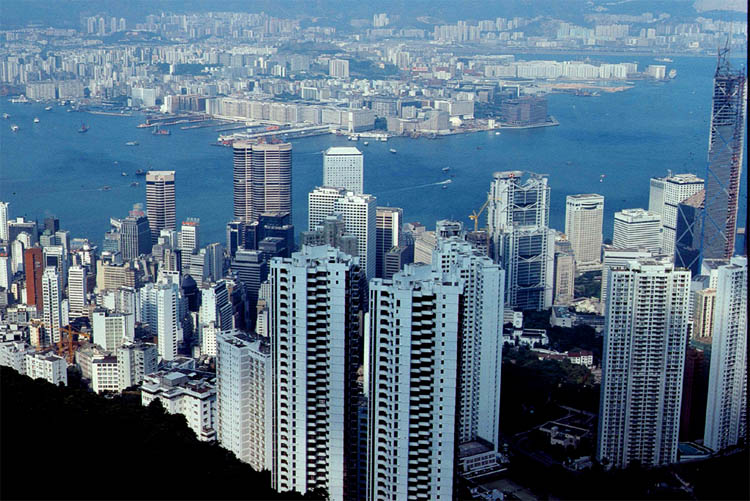
| most high-rise buildings are new
|
Since Hongkong city almost has reached its limit, the building boom continued in Aberdeen, on the other side of Hongkong Island. In 1969 it was a small village with small houses only. But even the new high rise buildings seem to be built the old fashioned way: all natural bamboo scaffolds.

| Some buildings in Aberdeen are still very old
|
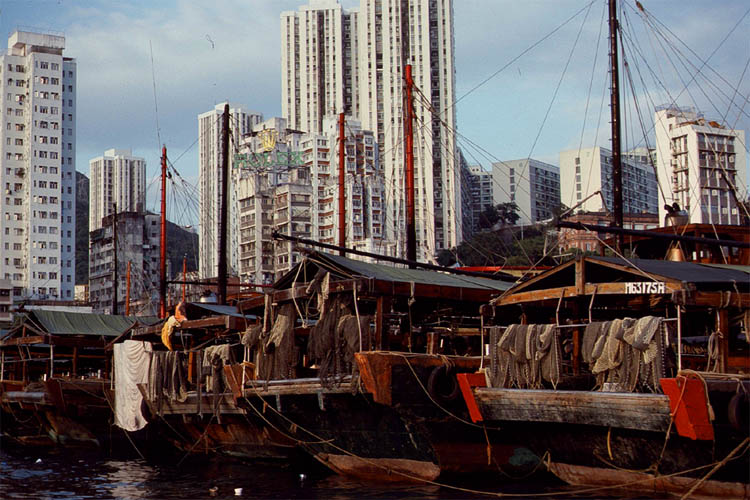
| also some people are still living on their boat
|
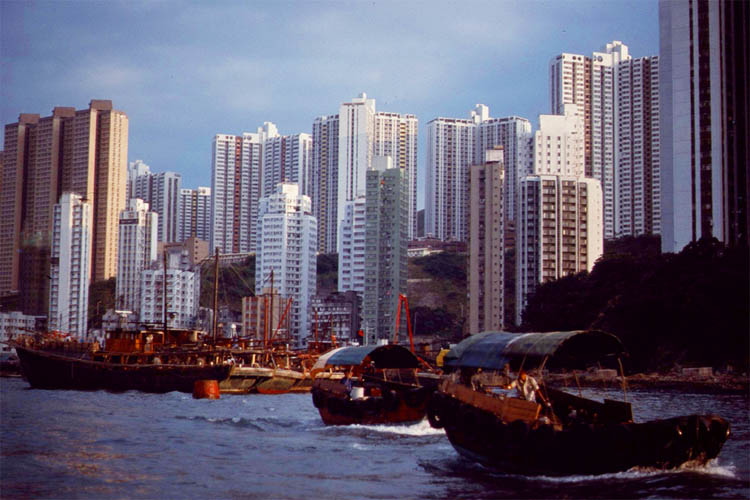
| But many new buildings could be seen
|

| during an obligatory harbour cruise in Aberdeen
|
Also the old Chinese junks are still being built with wood the old way but with modern tools. Thus the Aberdeen harbor cruise in a junk was a must, so was eating in the floating restaurant. This was also our farewell dinner (paid around 12 USD per person). Christine and Francoise didn't want to go to Mainland China. Their time was also limited.
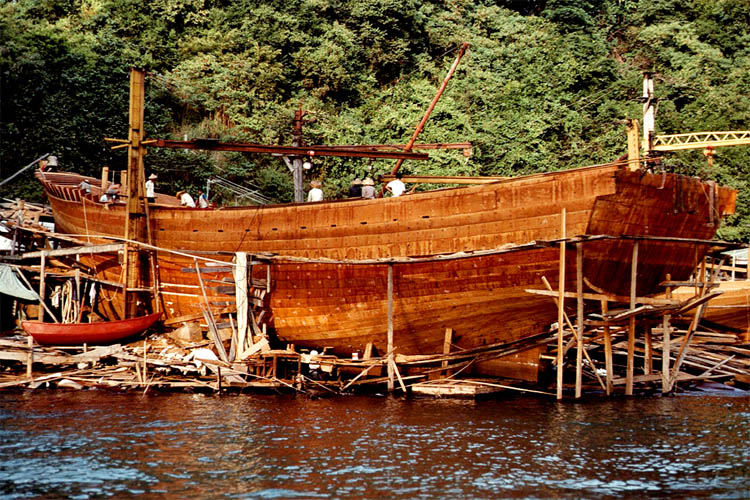
| Not only houses are being built but also a new junk
|

| The Chinese food in the floating restaurant is no junk
|
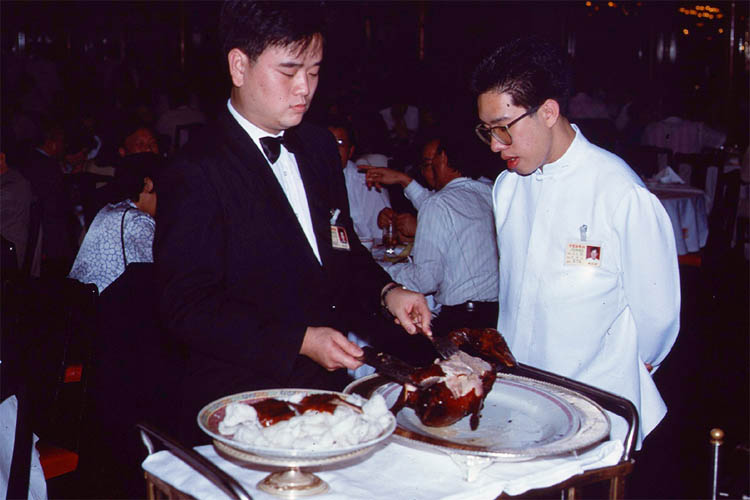
| Everybody's favourite dish is a Peking Duck
|
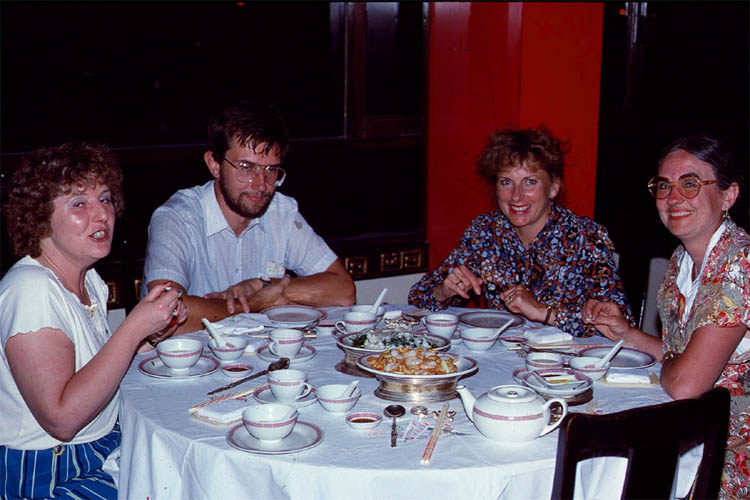
| with a toast to wish everybody good luck
|
Sight-seeing on our own on our last day in Hongkong. Let it pass before your eyes our last impressions before we come back in four weeks time.

| Next day sight-seeing is the temptation
|

| with all kinds of transport-ation
|
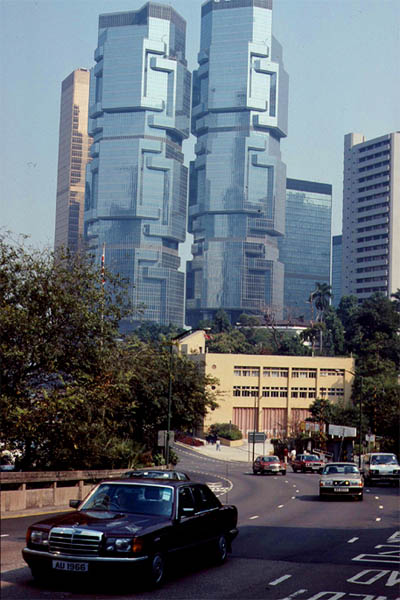
| Not much to see of the old city
|
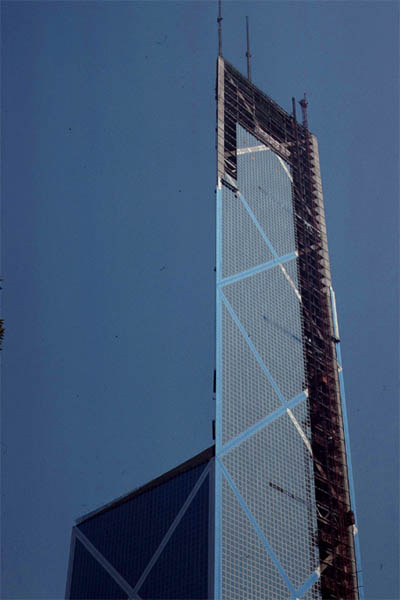
| Here was old Wanchai, it's a pity
|
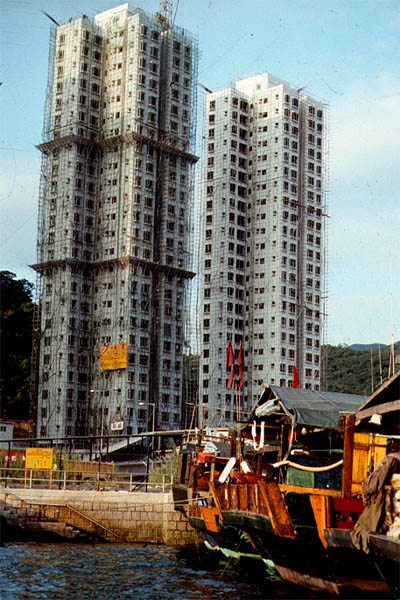
| Skyscrapers built with bamboo scaffolding in old fashion
|

| And a big generation gap between old and modern fashion
|
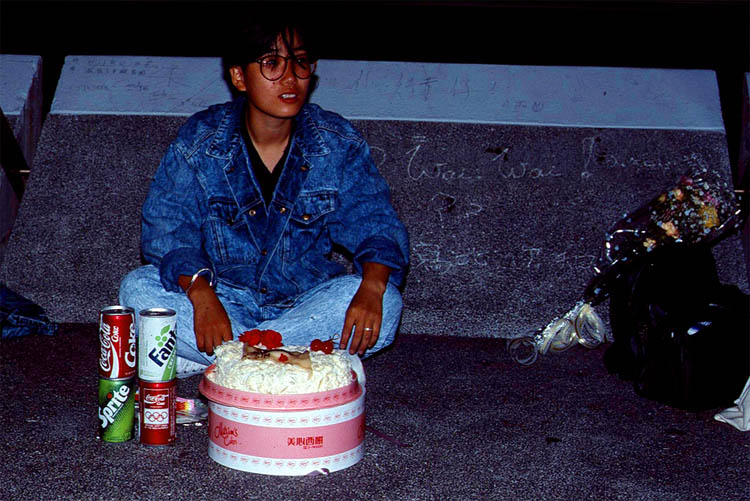
| Celebrating birthday on the bay walk in the night
|
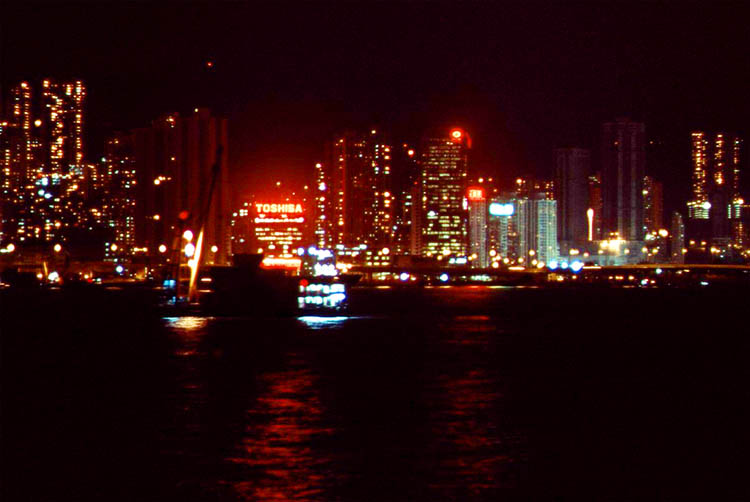
| with the Hongkong Island skyline on the other side
|
From Hongkong to Canton
We took the train from Kowloon to the border of China. Passport control was swift: people standing already in line waved us friendly to the front immigration counter. Never experienced this before.
Then we boarded the train leaving for Canton, or Guangzhou, as it is called now. As soon as we arrived we settled down at the
Youth Hostel
No, 2 Shamian 4th St
Guangzhou, China
|
and booked a double room for one night for around 5 USD .
Not much sight-seeing around now. We knew that we will probably come back. Most important was to change enough money and to book the ship to Wuzhou.
We didn't change much money at the border, because the official exchange rate was artificially high and we were looking forward to changing most of it on the black market, even if we had been warned to do that. And it was easier than expected and seemed to be common practice in all of China. In Canton we had been asked at every corner whether we like to change US Dollars (the going currency).
We almost did get the double amount of Yuans than the official Yuans as FEC (Foreign Exchange Certificate). The only setback was that for government controlled hotels (even the youth hostel) and airline tickets must be paid in FECs. So for one black market Yuan we had to pay around 0.30 US Dollar.
The money dealers still made it adventurous by directing us to a more quiet spot for the final exchange after having negotiated the rate. It's not only that you shouldn't do it under the eyes of the police but also that you do not have to deal with a crook trying to cheat you (first take the money and count yourself and stow away before giving out your US Dollars).
Then we had to rush to the pier to book the passage. And we were lucky that we did get the last tickets for two sleeping berth for the next day. Then we were even more lucky that we did get the emergency contingency berths as soon as we boarded the ship the next day, because the shipping agent actually sold us tickets for the next following day.

| Guangzhou (old name Canton)
|
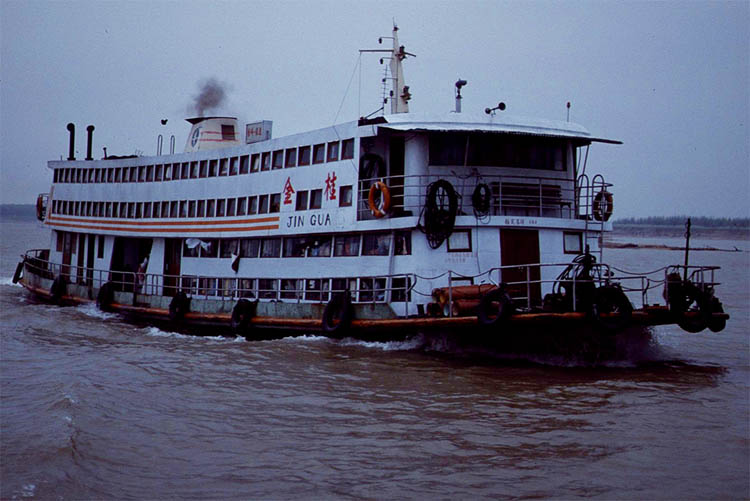
| Leaving by ship like this one
|
On the River to Wuzhou
We left around noon and sailed all night and that for only 3 USD.
The boat ride was actually very relaxing. You could stretch out on the bed and look out of your window, or walking around the ship to investigate the security standard. There was none, neither life-vests nor any fire-extinguisher, but the gas-burner heated up steadily water to be used by everyone for your own cup and tea. Chinese never travel without it. The food, though, was frugal, just rice. We also had some of our own provision. Then finally it was time to go to bed and I had a good night's sleep.
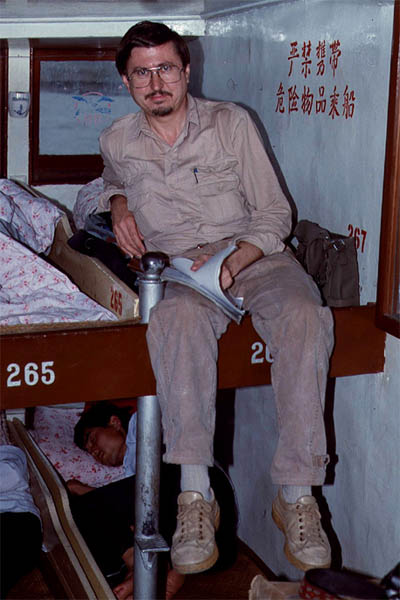
| My berth is small but nice
|
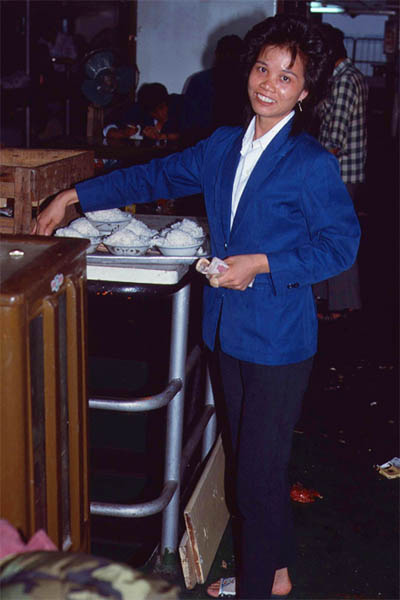
| It's also nice to get some rice
|
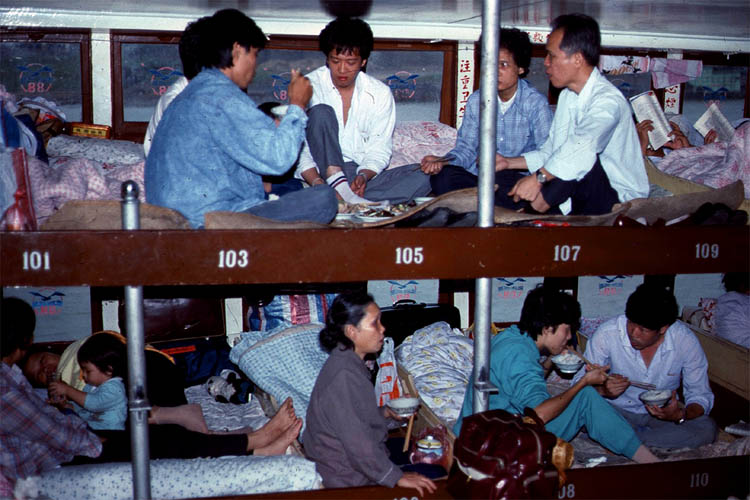
| My fellow travelers had fun
|
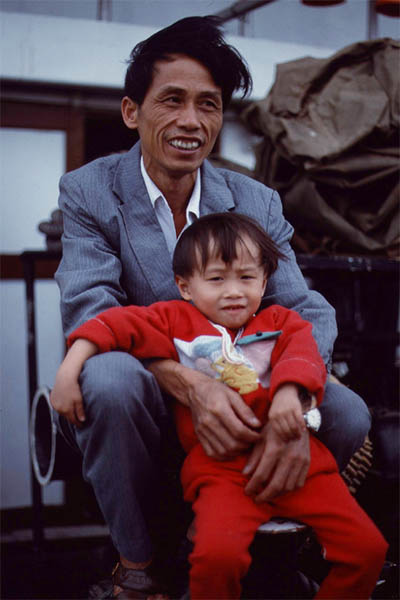
| On the deck I met a father and his son
|
By bus to Yangshuo
We arrived in the morning in Wuzhou. Not much of a town. So we hopped on the bus in order to get to another river at Yangshuo in the middle of the famous limestone mountains. The ride was really rough on the old bus and the bumpy road, and dangerous. It took 10 hours for the 300km despite our hell's driver overtaking trucks at curves and around rocks I would have never dared. The result of other dare devils we could see along the road, or were finally stuck behind an accident which just happened on our way. A lot of adventure for a 1.50 USD fare.
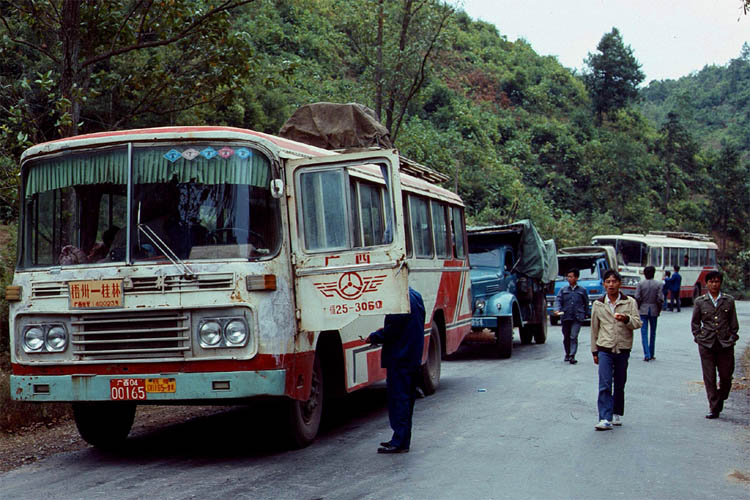
| Our bus suddenly stopped
|
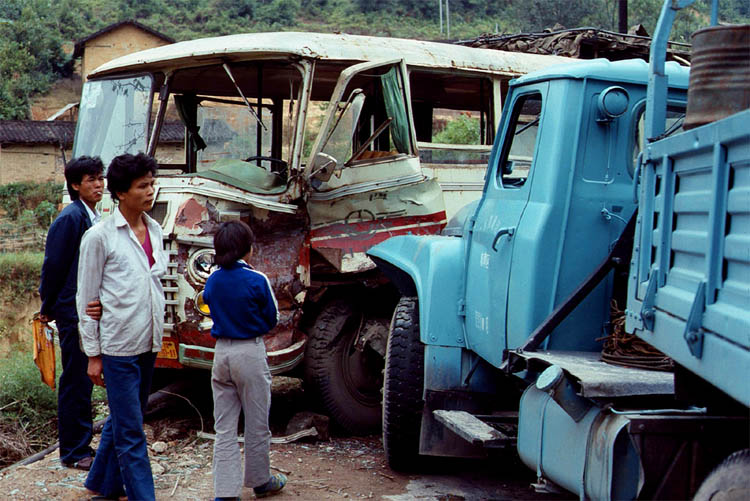
| There was an accident in front
|
Yangshuo
When we arrived in Yangshuo, it looked very bleak. It was raining and cold. The houses all looked grey. So did our youth hostel where we stayed for 3 USD per night. Not much to see of the hills around in the mist. During our stay the sun never came out. But we wanted to stay, because this was a traveler's town with many guesthouses and small restaurants. This was also the town in the middle of the countryside with all its fantastic hills around and at the river to start the river cruise to Guilin. Let the following pictures explain themselves.
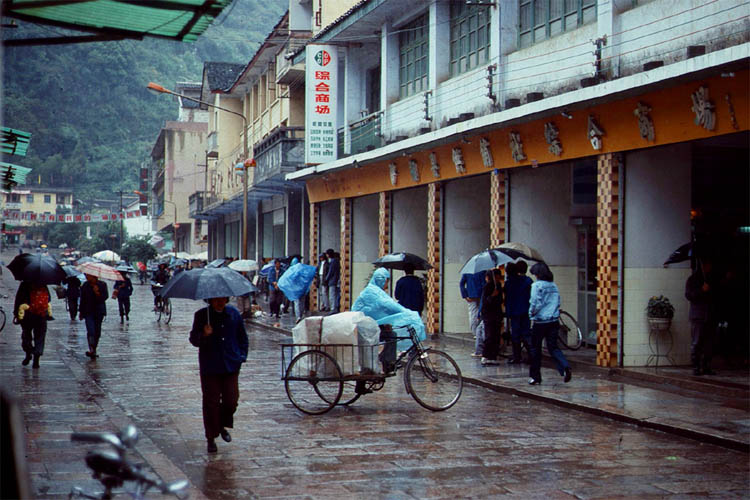
| A town in the rain always looks sad
|
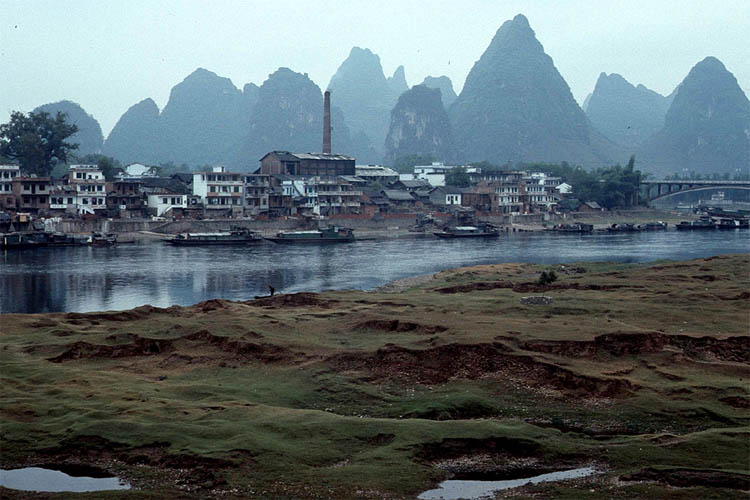
| But the hills around were not bad
|
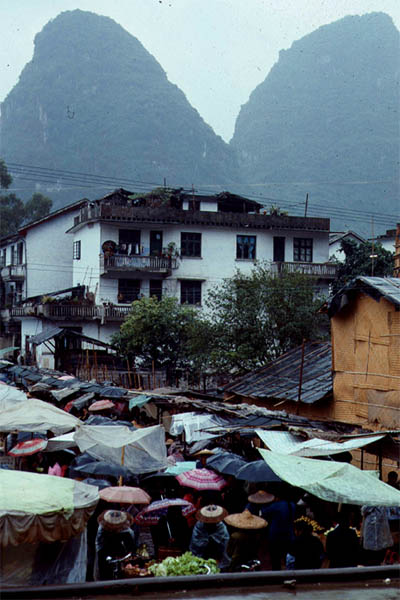
| With a market place in the middle
|
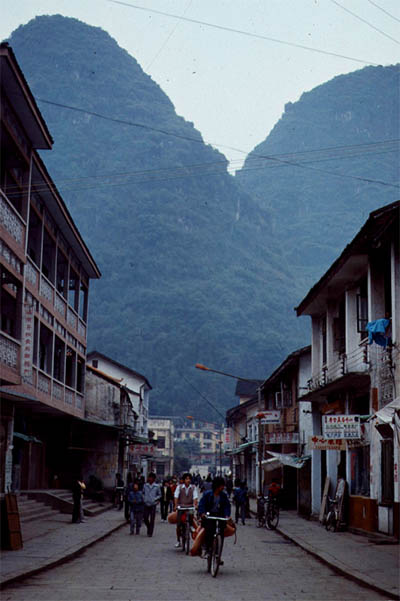
| and finally the rain stopped a little
|
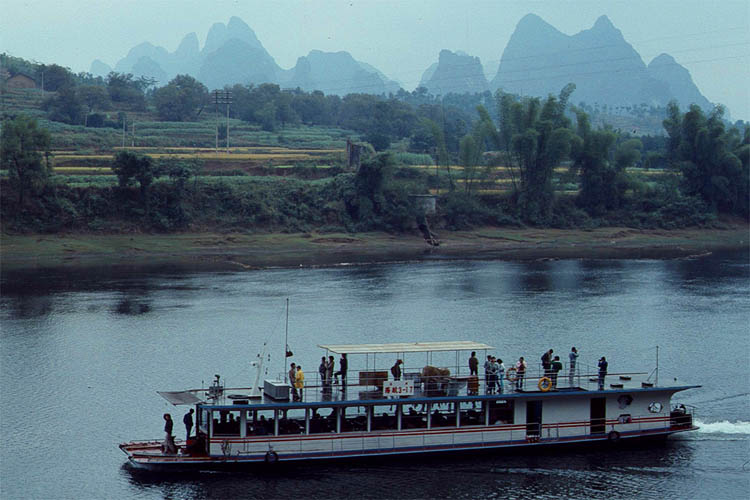
| From here we want to leave by boat
|

| but only after we have looked around
|
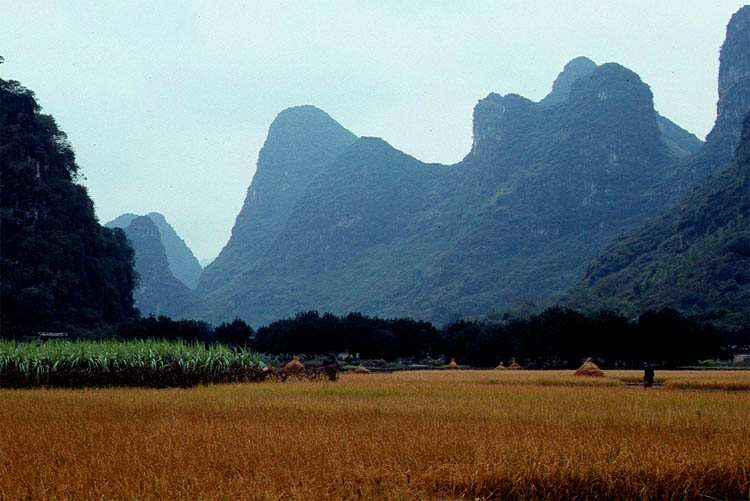
| Climbing hills wasn't recom-mendable
|
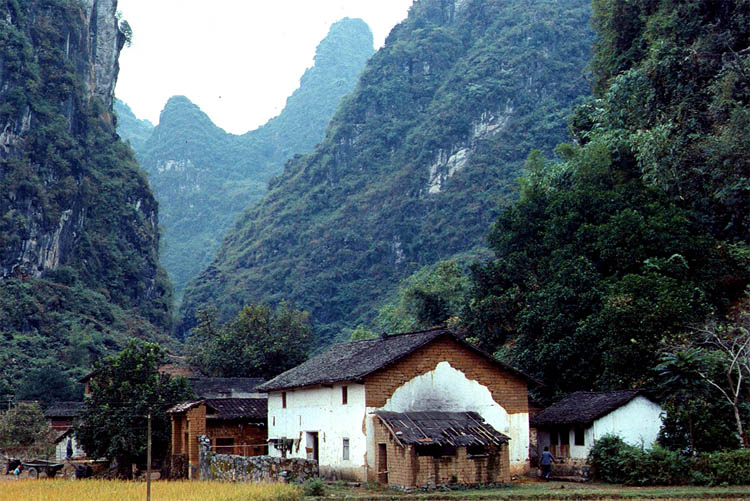
| but rather getting as close as possible
|
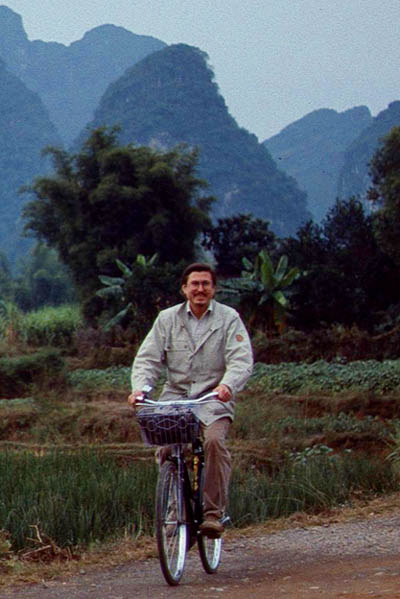
| It is best to go around by bike
|
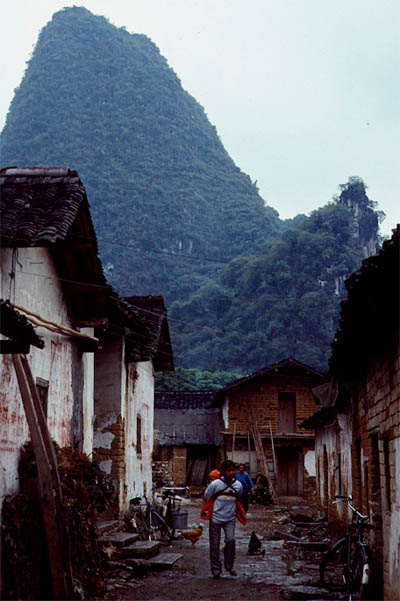
| to see more of the country life
|
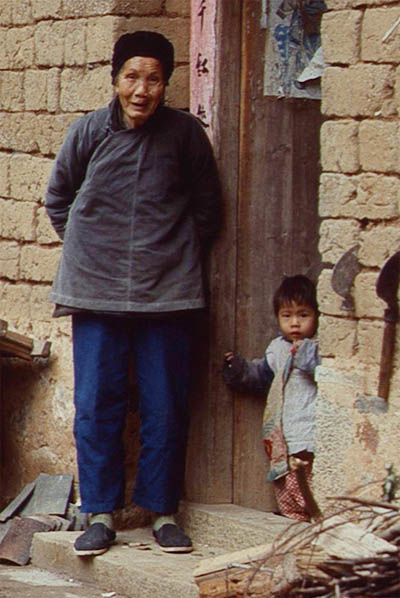
| The young people and the old
|
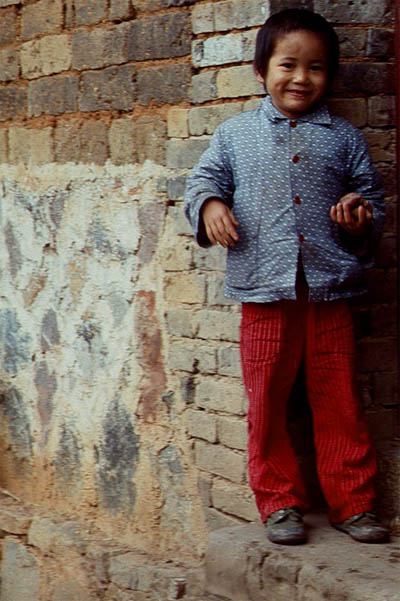
| are living together under one roof
|
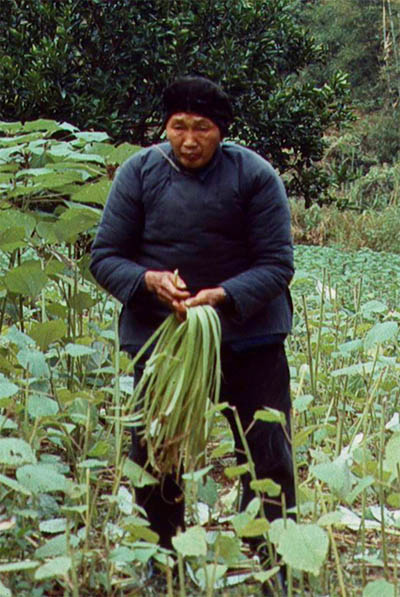
| The old people are working as long as they can
|
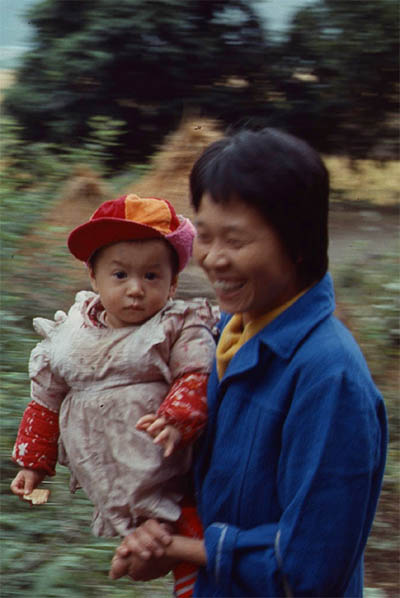
| until they will be taking care of by their children
|
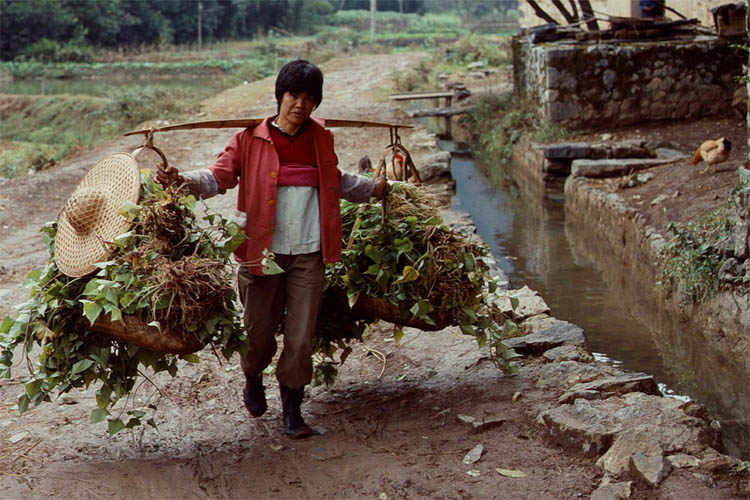
| Working hard in the field
|

| What did those plants yield?
|
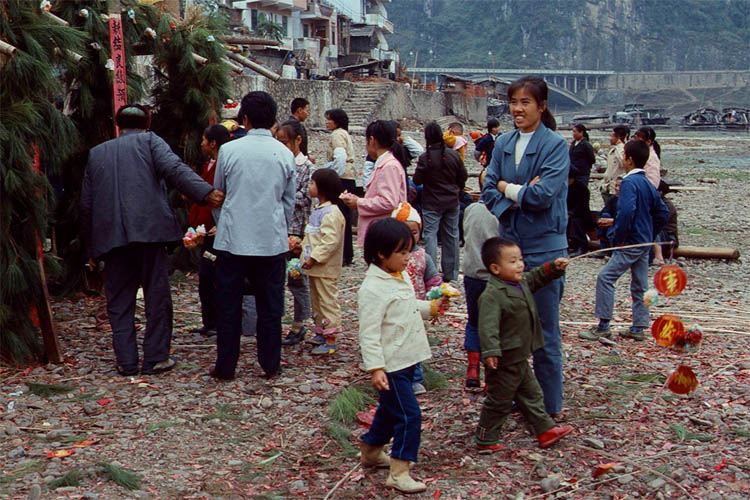
| There seemed to be a festival with some fun
|
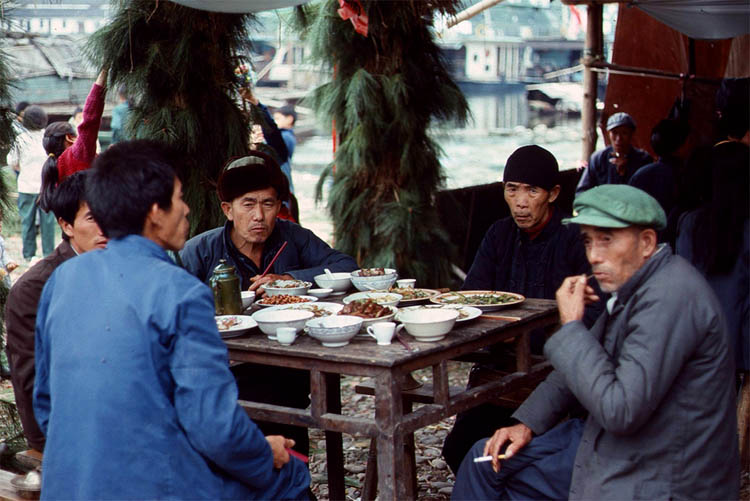
| This seemed to be a serious business lunch
|
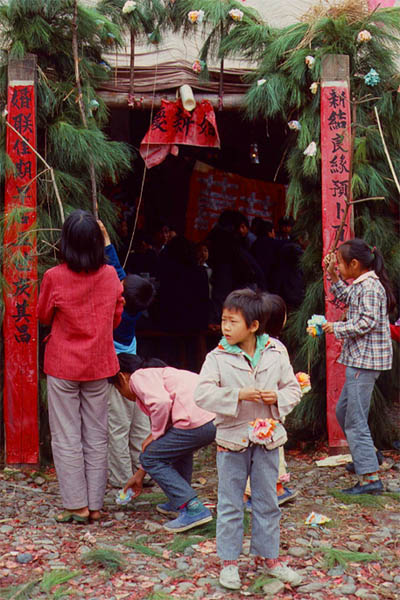
| A communist party party?
|

| With free rice for the hungry
|

| And a recruitment for the Comintern
|
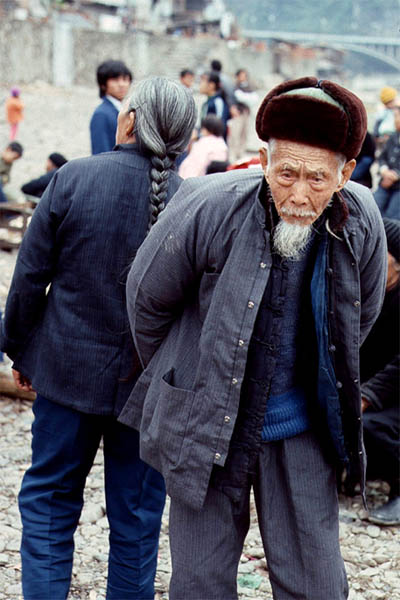
| What can this old veteran tell
|
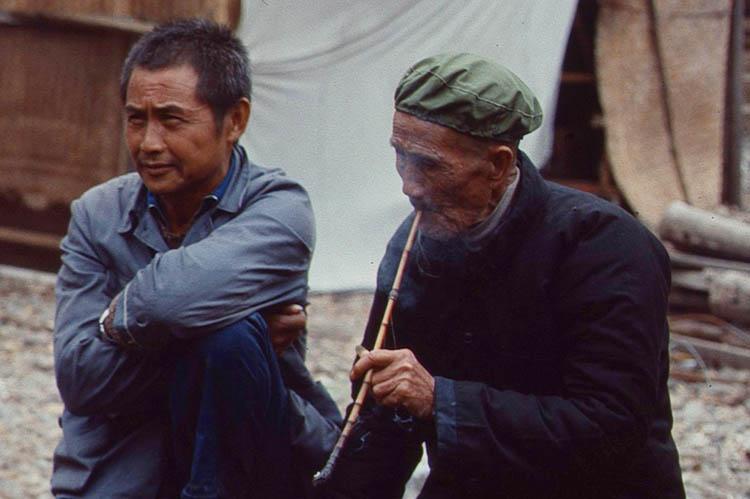
| Is the guy on the right even left from the opium war?
|

| Have they gone through the Cultural Revolution to look that sore?
|
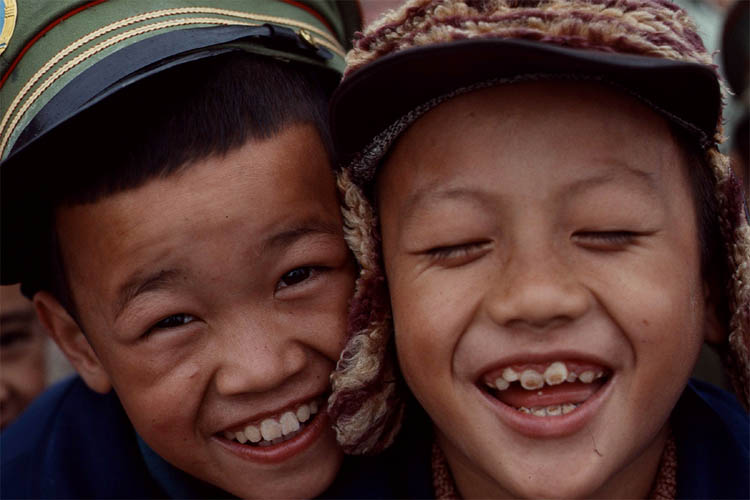
| Children seem to be more the happy generation
|
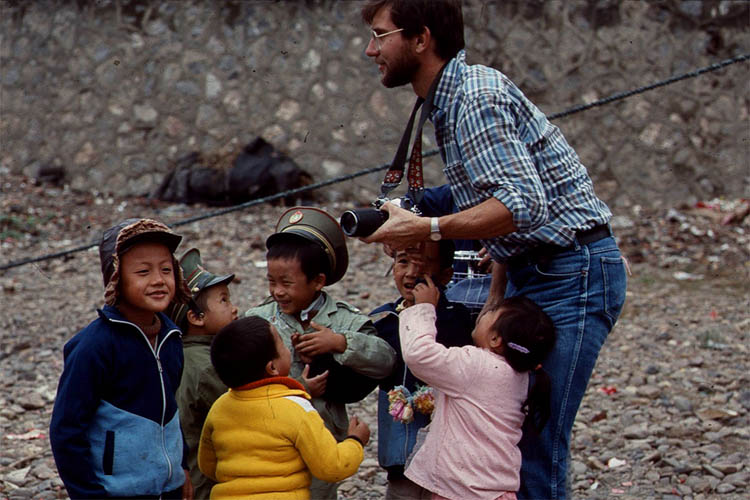
| And are more interested in the technical revolution
|
From Yangshuo to Guilin
After two nights in Yangshuo we finally embarked on the Li River cruise (for 3.50 USD). It was fantastic despite the bad weather. Especially to pass along the hills around. And much more was to be seen, like the fishermen catching fish with the help of their trained cormorans: tighten their neck with a cord so that they can breathe but not swallow the fish they caught. The only thing the fisherman has to do is to take out the fish from the beak of the cormoran and let it go for another catch.
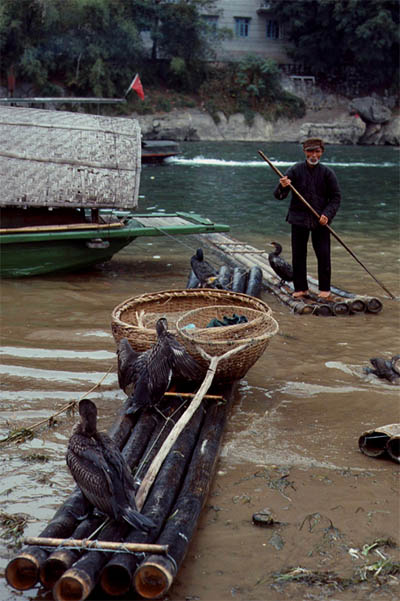
| The fisherman uses cormorants for fishing
|
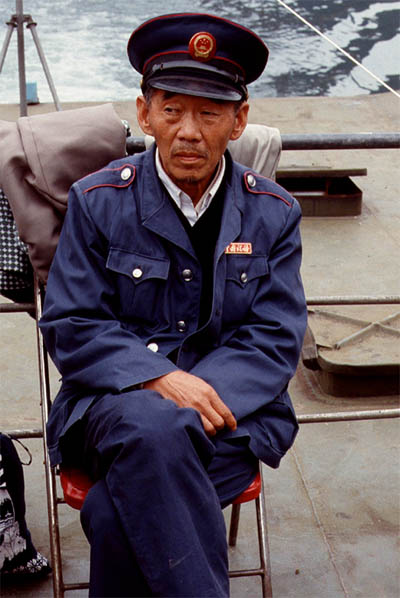
| Guarding the ship must be very boring
|
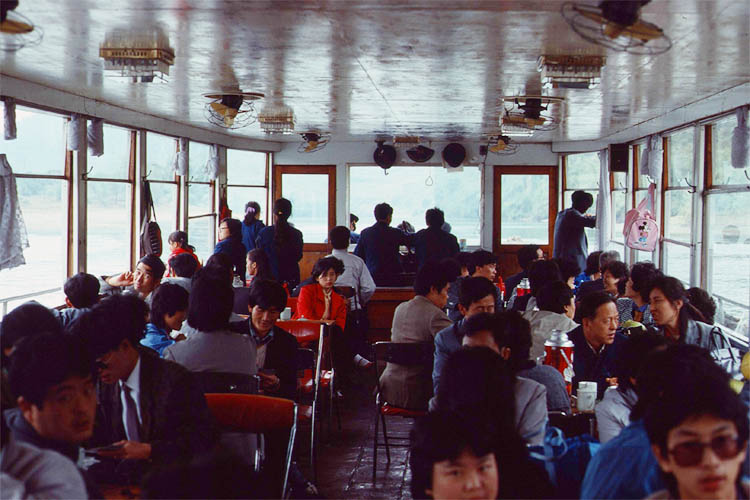
| Finally we embarked on the river cruise ship
|

| to go on a most wonderful scenic trip
|
All the hills around consist of limestone, created by oceanic organism, like sea shells. Yes, this area was covered by the ocean millions of years ago. When the sea receded, all soft sediments in between the limestone had been washed out thus creating this picturesque landscape.

| There also was some other waterway traffic
|
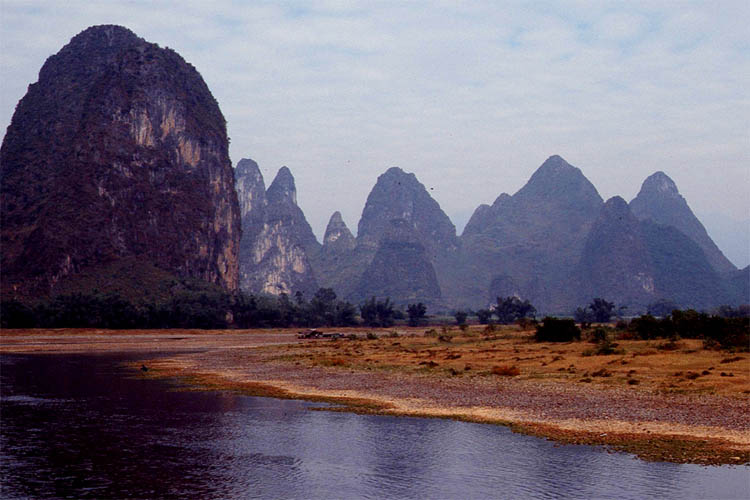
| And the sights became more fantastic
|
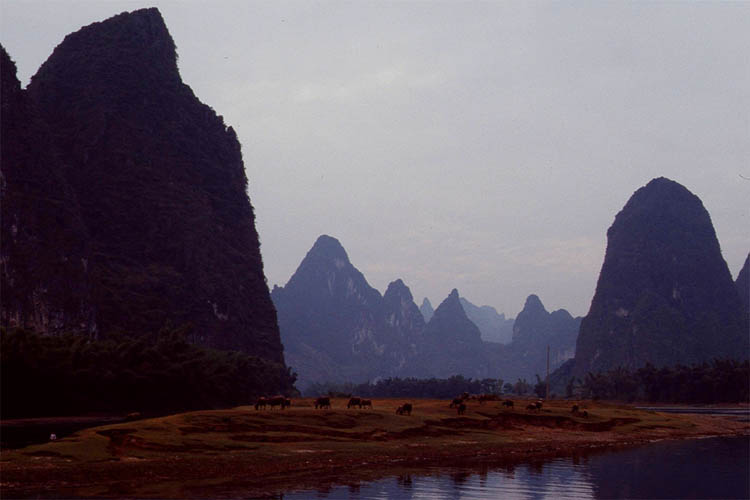
| Though, not much grass for the cattle was seen
|
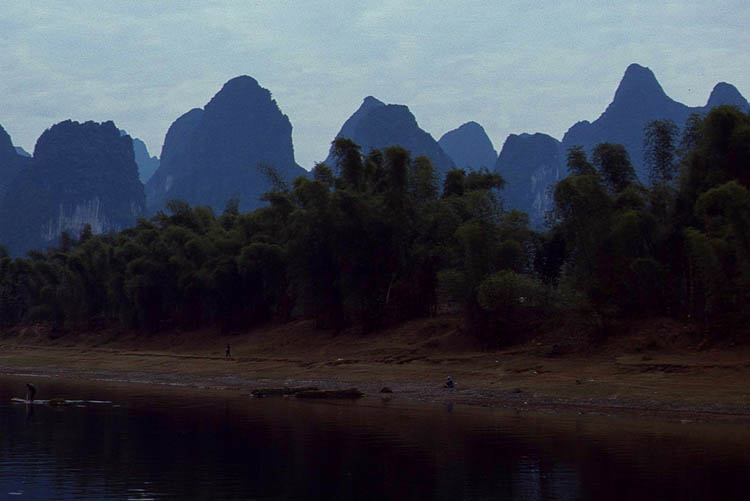
| Only the bamboo on the riverbank is green
|
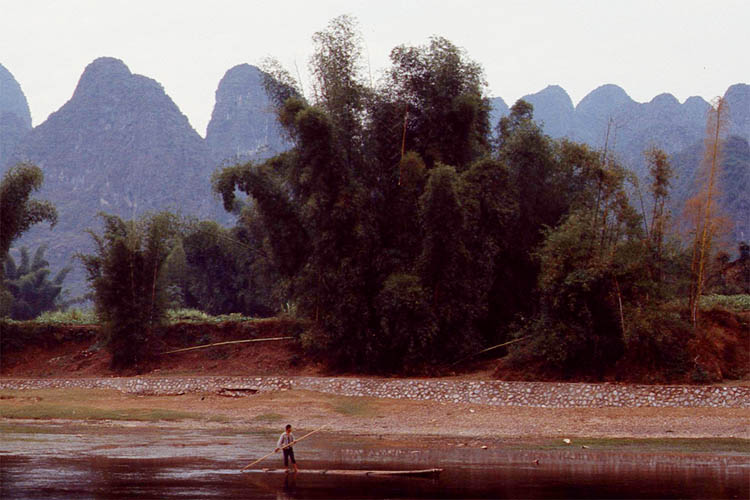
| Not many people are around
|
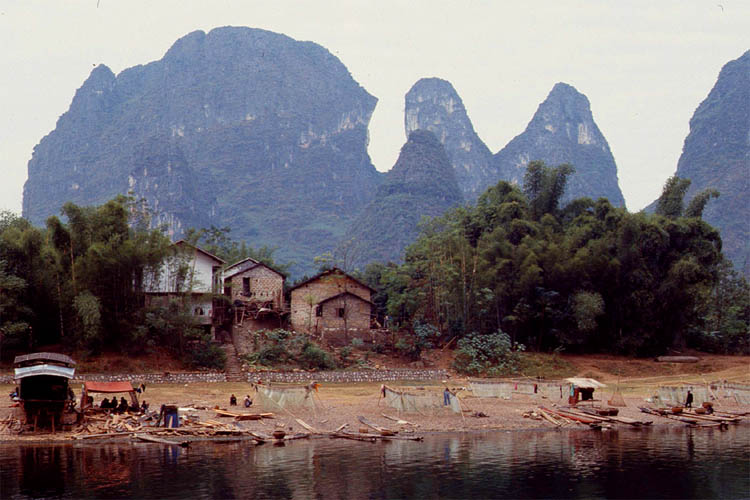
| Also villages are not abound
|
Guilin
Halfway to Guilin we had to disembark because of low water level. May to September would have been the best time to cruise all the way, but it was November and thus we had to take a bus for the last stretch to the city.
Guilin didn't have much to offer except for climbing the surrounding hills while exploring caves, which was not our thing.
The only thing I remember were the restaurants, where you can choose the live animal, whether snake, frog, dog, etc., you want to eat from any of the cages on display. You know, the Chinese eat everything which can run, jump or crawl, and they want to be sure it is fresh, what is understandable after our many meat scandals. So we only stayed one night in the Hidden Hill Hotel for 6 USD the double.
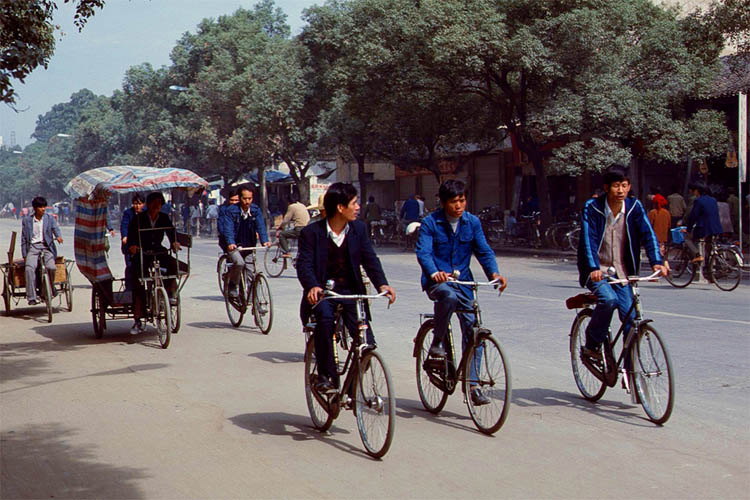
| Not much to be seen
|

| in the streets of Guilin
|
Even the fact that Guilin was visited by many foreign tourists, we still seemed to be aliens for the locals. Everybody looked at us and stopped when we stopped. And having Manfred's shoe repaired was an interesting event for the locals.
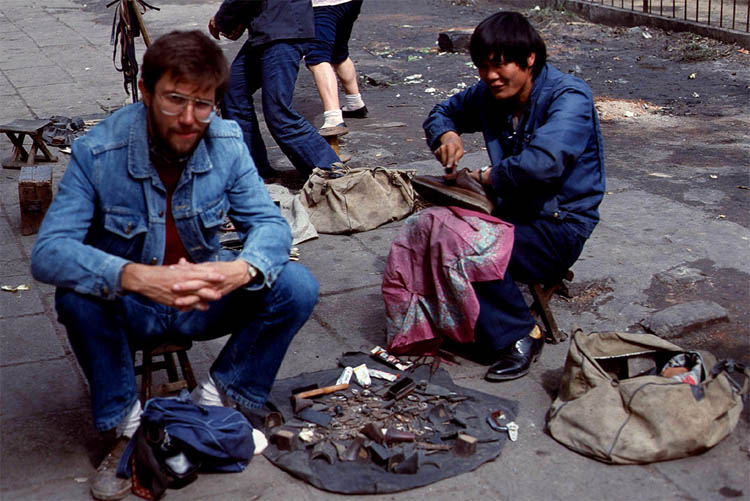
| But for the people of Guilin
|
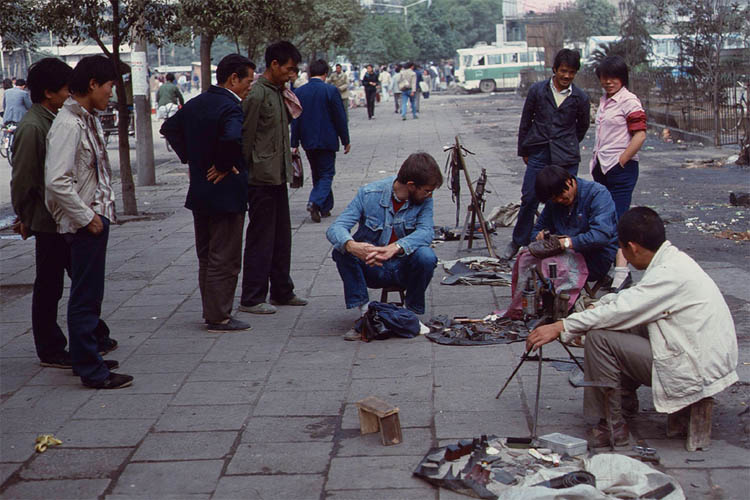
| there was much to be seen
|
So we were eager to get out of here. But not before Manfred had bought a souvenir.
Our next destination was Kunming. Instead of taking ground transport for that distance, we booked a flight for the next day for 50 USD.
If you want to skip now to the other parts, then just hit
Part II - Kunming, Dali, or
Part III - Nanning, Hainan, Canton
| 









































































